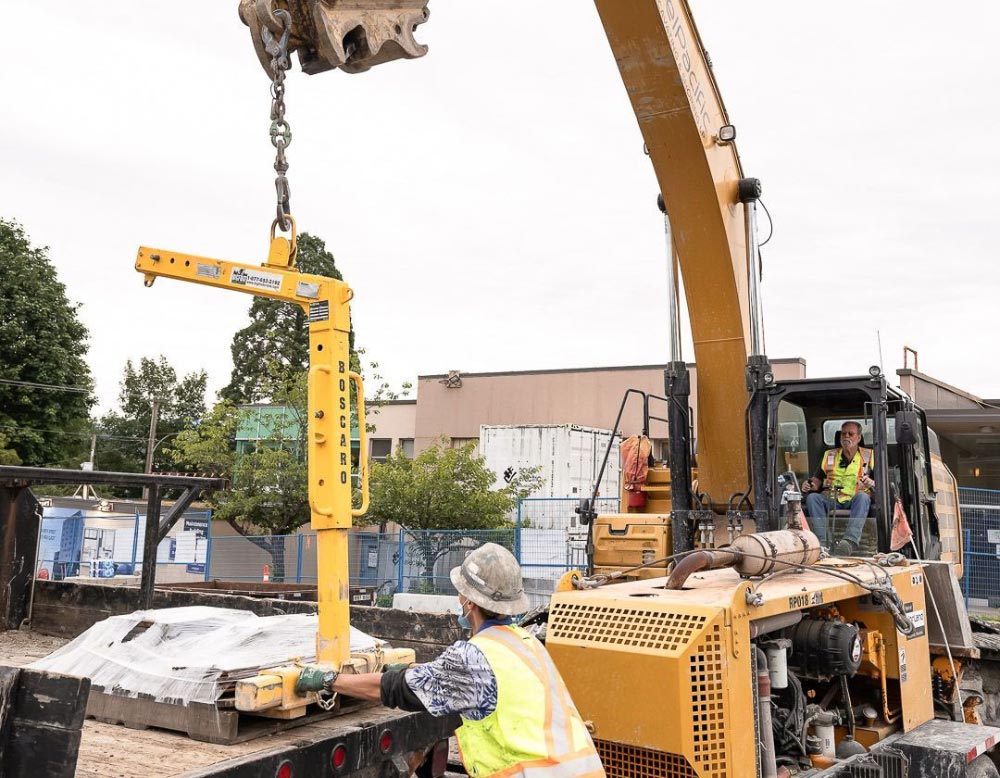Civil rigging focuses on civil infrastructure projects. It requires a deep understanding of load dynamics and safety protocols. Obtaining a civil rigging certification enhances safety and efficiency, reducing accidents and fostering trust among stakeholders.
Promoting early exposure to skilled trades like crane operation, Bigfoot Crane Academy’s training programs aim to fill the job gap. They believe in engaging children, not just teens, to build futures.
Are you looking for a challenging and rewarding career in the construction industry? A tower crane service technician might just be exactly what you’re looking for. What does it involve? …
Are you looking for a challenging and rewarding career in the construction industry? A construction hoist operator is responsible for operating and maintaining the hoist equipment used to transport workers, materials, and equipment to and from…
What Are the Top Eight Uses of Crane Pallet Forks?
You’ll be amazed with how many different uses you’ll find for pallet forks on the construction site or in the factory. Whether outdoors under the hook of a tower crane or mobile crane, or indoors under the hook of an overhead crane, you’ll never regret buying this essential accessory for your crane.
Sure, you probably have a forklift on the factory floor, right? Forklifts may be quick and easy when there is ample room to move, but what about when space is tight, and it makes better sense to utilize that overhead crane with a handy pallet forks attachment?
The same goes for the construction site where the all-terrain forklift is getting used regularly. It works great until it doesn’t, like when space is confined, and access is restricted. Then it makes good sense to use that crane that’s already on site and fit it with the pallet forks attachment.

Explore the eight different uses listed below and let us know if you’re interested in looking at a new set of pallet forks:
Moving Pallets
Maybe it’s the obvious one, but it’s definitely the most common reason to buy the pallet forks attachment. It just makes moving pallets easier, whether you’re delivering them where they need to go, or just rearranging. Especially when space is tight and overhead access is the most reasonable route, pallet forks become the most reliable choice for effortlessly moving palletized materials.
Stop Dragging and Start Lifting
One of the best things about cranes is that they lift up, up and away. It’s common to see oversized objects being dragged from place to place on job sites, or pushed around here and there in the factory, but these options are usually messy and risky. Save yourself the hassle by utilizing pallet forks under the hook of a crane to do the lifting.
Stacking Supplies
One of the best capabilities of pallet forks under the hook of a crane is the reach. With a pallet forks attachment, you can stack supplies where they need to go and reach the top as easy as ever when you need to access the supplies. This option is especially valuable when space is at a premium on your job site or in your factor. With this option in mind, your pallet forks can save you high-priced space, in addition to labor and time.
Moving Equipment Boxes
Whether it’s for the plumbers or the HVAC guys, moving around heavy equipment boxes around the site or factory can be a major annoyance. But with pallet forks you can eliminate the trouble and stress by lifting these heavy items above the busyness below. Your workers will love you for the convenience of it, and you’ll probably save time and money in the process.
Delivering Roofing Materials
Since there’s pretty much nowhere on a construction site that a crane cannot reach, with your pallet forks attachment you can deliver materials to anywhere, even the roof! That is just way beyond what a conventional forklift could do. Your roofing crew will love the specific and strategic placement of their shingles or tools or other necessary supplies directly to where they need them. And the cleanup process will also be made safer and more efficient. Pallet forks can be of great assistance to any roofing project.
Loading and Unloading Supplies From Trucks
Whether you’re unloading supplies from the back of a pickup truck or getting an order delivered from a tractor-trailer, having pallet forks available will make the loading and unloading process much more manageable, especially when the staging for the product is a few floors up, or the space around the truck is limited. Apologies to the forklift, but instead of dispatching a ramp, bring in the crane with pallet forks.
Lifting and Maintaining Machinery
Some of the machinery on your job site or in your factory will need to be moved from time to time to make room or clear a path. Sometimes that maneuver will be far easier to perform from above by way of a crane and pallet forks. As well, sometimes that machinery needs to be worked on from below and pallet forks can allow you to raise it to a comfortable height to be looked at and serviced.
Relocating Heavy Objects
Whether its transporting equipment like generators or delivering major appliances like refrigerators, relocating heavy objects on site can be made easy and safe with your pallet forks attachment. Bulky items like these can be a headache to move and require sometimes require far more labor than necessary. Bring in the pallet forks to save time, energy, and money.

Conclusion: Making Cranes Infinitely More Useful
That’s just what accessories do, right? In the case of cranes, accessories make them far more versatile and useful. The pallet forks attachment allows cranes to be used in ways that would otherwise be impossible with pallet-sized loads. That’s why crane owners and operators alike love to accessorize their cranes and explore the innumerable possibilities of lifting and moving.
In summary, pallet forks are a good investment as a crane accessory. The above eight uses are probably just the beginning for you, whether in your factory or on your construction site. Yes, in many cases, forklifts are being used to perform standard tasks, but they don’t always work in confined spaces, nor do they reach the heights of cranes. In addition, they can easily carry a price tag of $100,000 or more. So, if you’re already utilizing a crane, it may be worth your while to consider the pallet forks attachment at a fraction of the cost. They may become the easiest, safest, and most feasible option for lifting and moving heavy items around your job site or factory. And when you start finding other creative uses for them, let us know!
For a look at some of the world’s highest quality Italian-made pallet forks, click here.
To watch a video about Bigfoot’s innovative self-levelling Boscaro Pallet Forks, click here.
In March 2023, WorkSafeBC will implement new regulations for tower cranes in B.C. that will require the use of anti-collision/zoning systems. This development comes in response to newer technology that helps to ensure the safer use of tower cranes by…
We decided to share this post for two reasons:
First, it’s thesaurus day! Never knew it was a day and we want to share the meaning and explanation of a word “integrity” (which is one of our Core Values at Bigfoot). Second, we found this amazing article by the Smart Company based in Australia. For us at Bigfoot…
We’re talking about a concrete bucket under the hook of a crane, whether a tower crane or a mobile crane. Either way, these buckets are most likely to be seen on big construction sites where there are multiple delivery systems being utilized to bring concrete to where it needs to go…
We celebrate the women who have worked with Bigfoot and who have demonstrated a strong work ethic, great skills, and grit. On the right in the photo above is Safety Officer, Jen Mutas (In Part 1, we interviewed the woman on the left, Sandra Allard, Crane Technician). We sat down…
With over 2 decades of experience and expertise in the heavy equipment industry Ralf has a solid reputation and impeccable safety record. With focus, skill and intent Ralf successfully navigated himself through the ranks of some of Canada’s largest crane rental…
Receive Industry Updates
Contact
Bigfoot Crane Company Inc.
TSBC License: #LED0205236
2170 Carpenter Street
Abbotsford, BC V2T 6B4
Toll free:
Local:
Fax:
Email:









